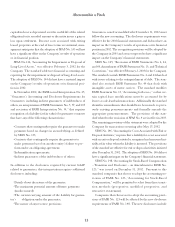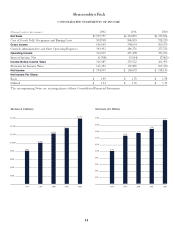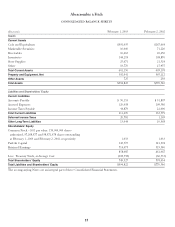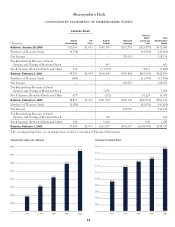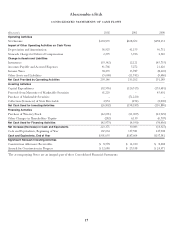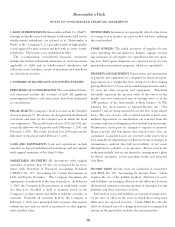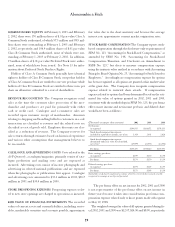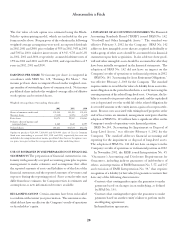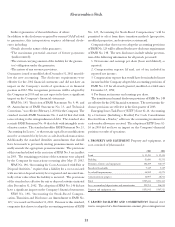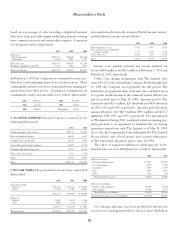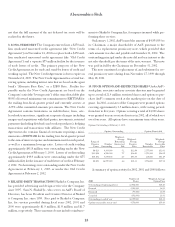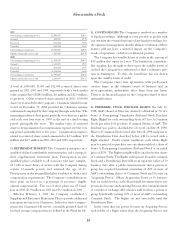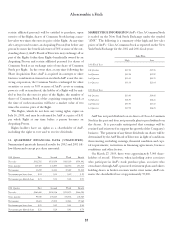Abercrombie & Fitch 2002 Annual Report Download - page 24
Download and view the complete annual report
Please find page 24 of the 2002 Abercrombie & Fitch annual report below. You can navigate through the pages in the report by either clicking on the pages listed below, or by using the keyword search tool below to find specific information within the annual report.
Abercrombie &Fitch
■Indirect guarantees of the indebtedness of others.
In addition to the disclosures required by current GAAP related
to guarantees, this interpretation requires additional disclo-
sures including:
■ Details about the nature of the guarantee;
■ The maximum potential amount of future payments
■ (undiscounted);
■ The current carrying amount of the liability for the guaran-
■ tor’s obligation under the guarantee;
■ The nature of any recourse provisions.
Guarantees issued or modified after December 31, 2002 must fol-
low the new accounting. The disclosure requirements were
effective for the 2002 financial statements and did not have an
impact on the Company’s results of operations or its financial
position in 2002. The recognition provisions will be adopted by
the Company in 2003 and are not expected to have a significant
impact on the Company’s financial statements.
SFAS No. 145, “Rescission of FASB Statements No. 4, 44, and
64, Amendment of FASB Statement No. 13, and Technical
Corrections,” was effective February 2, 2003 for the Company. The
standard rescinds FASB Statements No. 4 and 64 that deal with
issues relating to the extinguishment of debt. The standard also
rescinds FASB Statement No. 44 that deals with intangible assets
of motor carriers. The standard modifies FASB Statement No. 13,
“Accounting for Leases,” so that certain capital lease modifications
must be accounted for by lessees as sale-leaseback transactions.
Additionally, the standard identifies amendments that should
have been made to previously existing pronouncements and for-
mally amends the appropriate pronouncements. The provisions
of this standard related to the rescission of SFAS No. 4 are in effect
in 2003. The remaining provisions of the statement were adopted
by the Company for transactions occurring after May 15, 2002.
SFAS No. 146, “Accounting for Costs Associated with Exit or
Disposal Activities,” requires that a liability for a cost associated
with an exit or disposal activity be recognized and measured ini-
tially at fair value when the liability is incurred. The provisions
of the standard are effective for exit or disposal activities initiated
after December 31, 2002. The adoption of SFAS No. 146 did not
have a significant impact on the Company’s financial statements.
SFAS No. 148, “Accounting for Stock-Based Compen-
sation–Transition and Disclosure–an Amendment to FASB No.
123,” was issued on December 31, 2002. Pursuant to this standard,
companies that choose to adopt the accounting provisions of FASB
No. 123, “Accounting for Stock-Based Compensation,” will be
permitted to select from three transition methods (prospective,
modified prospective, and retroactive restatement).
Companies that choose not to adopt the accounting provisions
of FASB No. 123 will be affected by the new disclosure requirements
of FASB No. 148. The new disclosures include tabular presenta-
tion of the following information for all periods presented:
1. Net income and earnings per share (basic and diluted), as
reported;
2. Compensation expense (if any), net of tax, included in
reported net income;
3. Compensation expense that would have been included in net
income had the Company adopted the accounting provisions of
FASB No. 123 for all awards granted, modified or settled since
December 15, 1994;
4. Pro forma net income and earnings per share.
The transition and annual disclosure provisions of FASB No. 148
are effective for the 2002 financial statements. The new interim dis-
closure provisions are effective in the first quarter of 2003.
Emerging Issues Task Force (“EITF”) Issue 02-16, “Accounting
by a Customer (Including a Reseller) For Cash Consideration
Received from a Vendor,” addresses the accounting treatment for
cash vendor allowances received. The adoption of EITF Issue 02-
16 in 2003 did not have an impact on the Company’s financial
position or results of operations.
4. PROPERTY AND EQUIPMENT Property and equipment, at
cost, consisted of (thousands):
2002 2001
Land $ 15,450 $ 15,414
Building 92,680 91,531
Furniture, fixtures and equipment 386,289 316,035
Beneficial leaseholds 7,349 7,349
Leasehold improvements 46,969 42,273
Construction in progress 36,905 28,721
Total $585,642 $501,323
Less: accumulated depreciation and amortization 192,701 136,211
Property and equipment, net $392,941 $365,112
5. LEASED FACILITIES AND COMMITMENTS Annual store
rent is comprised of a fixed minimum amount, plus contingent rent
21



